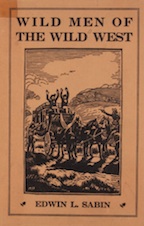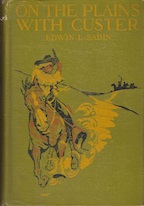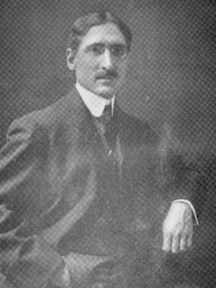By Nicholas McCarty
Oh, Western land, oh, Western land,
Of bounding blood, and red;
By peak and vale on leads thy trail
For those of fearless tread.
And he who shall elsewhere take his way
That once thy trail has pressed,
Must ever yearn, and dream return,
To thee, oh, magic West.
—Edwin L. Sabin
Edwin Legrand Sabin was born on December 23, 1870, in Rockford, Illinois. Within the first year of his life, the family moved to Clinton, Iowa. Sabin attended the University of Iowa until 1892, leaving in his fourth year to pursue a career as a news reporter. Following this departure, he worked for a number of well-known news agencies, including the Des Moines Daily News and Campbell’s Weekly. While working in Chicago, Sabin met Mary Nicole Nash. The two were married on October 7, 1896. Four years later, Sabin decided to return to the University of Iowa in order to complete his undergraduate degree. He graduated with Phi Beta Kappa honors in 1900. At that time, the Alpha of Iowa Chapter of ΦBK had existed for only five years.
Upon graduating, Sabin resumed his newspaper career and began writing historical non-fiction, novels, short fiction, and poetry. In October of 1906, The Iowa Alumnus included this generous description of his work:
“Few sons of the University in recent years have gained wider recognition in their chosen fields of work than has [Edwin] Legrand Sabin…as a writer of pleasant stories and light verse. It is probable that his name is more familiar to the reading public than that of almost any other alumnus of Iowa through its frequent appearance during the last few years in The Century and other leading magazines, as well as in Puck.”
In 1911, Sabin began receiving considerable attention for his work on the famous figures and history of the American West. According to correspondence between Sabin and his publisher at the time, it was with success in mind that he decided to move to La Jolla, California, in order to be closer to his work. In the early twentieth century, California was considered the capital for the literature and history of the West. It was there that Sabin had his most productive years. From 1913 to 1931, he published a number of critically-acclaimed novels, mostly adventure books for boys. He read vigorously, wrote without pause, and became obsessed with uncovering the truth. Sabin narrated stories as if they were a continuous confrontation between heroism and villainy. In Wild Men of the Wild West (1929), he writes: “All in all there is little romance in man killing man. At the best it is a grim business and a poor business. And to depend upon the gun likewise is a poor business.”


By 1913, Sabin’s work consistently received high praise. Following the publication of On the Plains with Custer (1913), his work became known for its accurate, carefully-researched historical detail as much as for the quality of his storytelling. He utilized letters written by General George Custer and Elizabeth Custer, as well as the work of biographers who had preceded him. Sabin was also notorious for tracking down individuals closely connected to these events. He managed to locate General Custer’s head scout, who served with Custer during the Battle of the Little Bighorn (American Indian Wars). Sabin traveled to Berkeley, California, to meet with the scout for information regarding the accuracy of his work on Custer. Sabin’s Kit Carson Days (1914) is still widely considered the most historically reliable account of Kit Carson’s life as a frontiersman.
Everything changed for Sabin on October 29, 1929, the date of the most devastating stock market crash in US history. The ushering in of the Great Depression would change his fortune for decades to come. Within two years of the stock market crash, the Sabin family had to move inland from their residence in La Jolla to a smaller home in Hemet, California. Sabin began work as a freelance writing consultant to make ends meet. He would mail flyers to aspiring authors, promising to help them prepare short stories, articles, and longer manuscripts for a fee of ten dollars. This project, as well as an additional attempt to establish an editorial firm, ultimately failed. The once famous author fell to still more desperate hardships.
Sabin’s income dwindled year after year. In 1941, he managed to make only $675.14, the equivalent of $16,000 today. His total royalties from Lippincott, with whom he had published eleven of his best-received novels, was only $113.13 in 1943. By 1947, his health had begun to fail considerably. Mary Nicole passed away on September 27, 1950. By 1951, Sabin was a ward of Riverside County, California. He passed away on November 24, 1952.
Sabin published 24 books and wrote over 100 poems during his lifetime. Nearly all of these works, in both complete and draft versions, can be found in the University of Iowa’s Special Collections Archives.
Nicholas McCarty is a junior at the University of Iowa majoring in Biochemistry. The University of Iowa is home to the Alpha of Iowa Chapter of Phi Beta Kappa.




